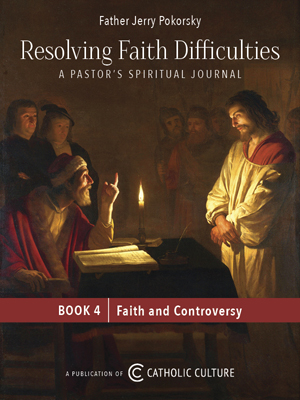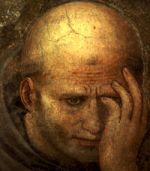Avoid discouragement, feed your soul: New books that can help
By Dr. Jeff Mirus ( bio - articles - email ) | Oct 23, 2018 | In Reviews
Given the problems facing the Church today, from both within and without, it is easy to become discouraged. It is easy to wonder whether it is any longer worthwhile trying to draw people into a Church which seems to do its best to betray them. And it is easy to wonder whether it is even possible to foster effective renewal in the Church.
But “getting religion” is a funny thing. People can be attracted to the Church for a wide variety of motives (called “motives of credibility”). The fact that she is still here, larger than life and incredibly active despite the colossal sins of her members, can actually be one of those motives of credibility. In my experience it is impossible to predict whether any given person will respond positively or negatively to a Church which is so obviously in need of heroic witness to Christ. In any case, the least likely people are often the most deeply touched when they encounter personal holiness in a Catholic priest, teacher, caregiver or friend.
But to be prepared to attract others to the Church in such troubled times we must learn to remain serene under pressure. In a communications apostolate such as CatholicCulture.org, this may not always be obvious, as so much of our communication is about problems in the Church which cry out for correction. For this reason, it is good to take a step back and ensure that we nourish ourselves not only with information about what is wrong, but with inspiration from the deep inner life of the Church—which of course is the life of Christ.
Some people find inspiration in outstanding films (in this category, I always think of Paul Scofield’s portrayal of St. Thomas More in the 1966 release of “A Man for All Seasons”). Others are uplifted by religious art (I find the various Madonnas of the sixteenth-century master Raphael to be magnificent). Still others nourish their spirits through great music (perhaps Johann Sebastian Bach or George Frideric Handel, or simply Gregorian Chant). And then there are the great churches of the world. Perhaps a visit to Chartres would be in order!
But more frequently I find inspiration in books. From time to time, amid all the distressing news and pointed commentary through which we attempt to stimulate ecclesiastical renewal, I like to look at what is new from trusted publishers. Today, I am deliberately avoiding both works of controversy and works of instruction, though both can wonderfully nourish us spiritually by prompting a greater apprehension of the truth. Instead, let me list some new books that speak to our souls more directly.
The Saints
The lives of the saints are a particularly apt starting point for two important reasons. First, each saint embodies a singular correspondence in his or her own life to that deep inner life of the Church which is Christ. Second, many saints achieve their appropriation of the Church’s inner life precisely by their particular response to the Church’s own weaknesses. But not all hagiography is created equal, so it is good to see Ignatius Press taking pains to bring back into print authors who have already proved they can tell a great story while inspiring their readers. Here are two of the latest new editions:
- Francis X. Talbot, SJ, Jean de Brébeuf, Saint among the Hurons (370pp) (originally published 1949): A Renaissance man in the first half of the twentieth century, Fr. Talbot edited four different Catholic publications, served as a college president, founded organizations devoted to books, poetry, libraries and theater, and wrote (among other things) biographies of two of the great saints who evangelized the Indians in America in the seventeenth century, the other being Isaac Jogues. Missionaries inspire because they do what the vast majority of the Church’s members are unable or unwilling to do, even at home.
- Gerald Muller, CSC, Father Miguel Pro: A Modern Mexican Martyr (155pp) (originally published 1969): You never know what will bring someone to write about a saint who preserved the Faith under conditions somewhat like our own. A Holy Cross Brother, Gerald Muller directed bands in Catholic high schools for nearly thirty years and headed the music department of a Catholic university in Texas for eighteen more. He also wrote over a hundred short biographies for children. This one, for adults, chronicles the life and ministry of a master of disguises who ministered to Catholics under Mexico’s atheist regime in the 1920s. (Oh, and at one time the author taught Mark Harmon, aka Jethro Leroy Gibbs.)
A new book about a saint comes from Image Books:
- A Call to Mercy: Hearts to Love, Hands to Serve—Mother Teresa (ed. Brian Kolodiejchuk, MC) (363pp) (2016, but just made available in paperback): This is a guide to the spiritual life using the words and example provided by St. Teresa of Calcutta. It is divided into fourteen chapters, each focused on Mother Teresa’s approach to one of the corporal or spiritual works of mercy. In each chapter, there is a brief introduction, a selection of passages by Mother Teresa, a section of brief accounts of things that she did, a reflection, and a closing prayer. The editor is the priest director of the Mother Teresa Center and was the postulator of Mother Teresa’s cause for canonization.
Catholic Art and Culture
From Sophia Press come two Catholic books which are remarkable for their use of the arts:
- Helen Hoffner, Catholic Traditions and Treasures: An Illustrated Encyclopedia (106pp) (2018): This is really a small coffee table book, published in hardcover with pages in full color, including both photographs and illustrations by Deirdre M. Folley. It is a guide to the many ways the inner life of the Church has been manifested over the centuries. Thus it covers the structure of the Church and her religious orders, the sacraments, the liturgical year, public Catholic devotions, private devotions, the titles of Mary, Catholicism in the home, devotional aids, what Catholics wear (medals, scapulars, vestments, habits), religious art, and “Catholic Books You Need to Know” (Bible, catechisms, prayer books). This is a delightful book, particularly valuable for families.
- Elizabeth Lev, How Catholic Art Saved the Faith: The Triumph of Beauty and Truth in Counter-Reformation Art (310pp) (2018): While not quite a coffee table book, this volume is printed on semi-gloss paper with full color prints of great Catholic paintings throughout. By some incredible omission, there is no biographical blurb for the author in this edition, but Elizabeth Lev is a noted art historian with expertise centering on Rome. The book tells (and illustrates) the story of how the Church used the arts in churches and worship to foster Catholic sensibilities following the Protestant Revolt. Broad sections encompass the sacraments, intercession, and cooperation with grace, with twenty-one chapters covering individual aspects of this life of grace, from the Eucharist through the saints and on to the war on sin.
Spiritual Essays
As I mentioned, I keep coming back to fine spiritual writing, and for me this can be of two kinds: The directly spiritual (such as reflections on Scripture and spiritual growth), and the indirectly spiritual (such as spiritually-pointed commentaries on the problems of our times). Here are two new ones in this category which have made the director’s cut:
- Fulton J. Sheen, The Cries of Jesus from the Cross (384pp) (Sophia Press 2018): Archbishop Sheen has needed no introduction since the days in the 1930s when he broadcast “The Catholic Hour” on radio and those in the 1950s when he hosted his own television program, “Life Is Worth Living”—reaching as many as thirty million people each week. Of course he also wrote 73 books between 1925 and his death in 1979, all while an active priest and bishop (Rochester). People are still fighting over where this potential saint’s remains should find their final resting place. This anthology of Sheen’s writings includes reflections related to Our Lord’s “seven last words” during His Crucifixion.
- George William Rutler, Calm in Chaos: Catholic Wisdom for Anxious Times (228pp) (Ignatius Press 2018): Fr. Rutler is a consummate essayist who delights readers through not only his spiritual insight but his ability to draw information—both pertinent and entertaining—from more aspects of life and history than you could expect anyone to shake a stick at. Accordingly, his essays are collected into books from time to time (I mentioned earlier collections in both 2015 and 2016). This latest collection, drawn from several sources over the past three or four years, but mostly from Fr. Rutler’s regular column in Crisis Magazine, emphasizes one of the points I had in mind at the beginning of this commentary. I mean the need to retain our serenity, no matter what.
All comments are moderated. To lighten our editing burden, only current donors are allowed to Sound Off. If you are a current donor, log in to see the comment form; otherwise please support our work, and Sound Off!








